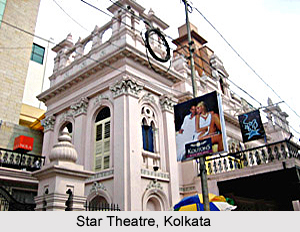 The Natyashastra by Bharata Muni depicts the mature form of a classical theatre of ancient India. Natyashastra is the most detail and elaborate of all treatises on dramatic criticism and acting ever written in any language. Bharata Muni here have discussed about a variety of topics in relation to the stage. The topics discussed in this work are: Mythical origin of theatre, its coming down to earth; construction of a play house, a stage, a tiring room and auditorium etc., ceremonies relating to the construction, preliminaries to a dramatic performance (ceremonies including songs, chants dances and instrumental music), choreographic elements (dance, gestures and movements of different parts of the body) and body in some conventional postures, costumes and make-up, classification of plays analysis of their structure, poetic aspects of plays and figures of speech in them, theory of music, metres of songs, chants, elocution, modes of playing instruments (Veena, flutes and drums) and Talas (time measure) to be observed during songs and playing of instruments, Roles and characters in plays (their classification, description and training of actors and actresses, members of theatrical troupes, and qualification of an ideal stage manager), criticism of a dramatic performance. Bharata Muni thus laid the foundation of the classical Theatre by composing the Natysastra.
The Natyashastra by Bharata Muni depicts the mature form of a classical theatre of ancient India. Natyashastra is the most detail and elaborate of all treatises on dramatic criticism and acting ever written in any language. Bharata Muni here have discussed about a variety of topics in relation to the stage. The topics discussed in this work are: Mythical origin of theatre, its coming down to earth; construction of a play house, a stage, a tiring room and auditorium etc., ceremonies relating to the construction, preliminaries to a dramatic performance (ceremonies including songs, chants dances and instrumental music), choreographic elements (dance, gestures and movements of different parts of the body) and body in some conventional postures, costumes and make-up, classification of plays analysis of their structure, poetic aspects of plays and figures of speech in them, theory of music, metres of songs, chants, elocution, modes of playing instruments (Veena, flutes and drums) and Talas (time measure) to be observed during songs and playing of instruments, Roles and characters in plays (their classification, description and training of actors and actresses, members of theatrical troupes, and qualification of an ideal stage manager), criticism of a dramatic performance. Bharata Muni thus laid the foundation of the classical Theatre by composing the Natysastra.
Types of Playhouse
In Natysastra Bharata has discussed about three types of playhouse, oblong, square and triangular. These three have been further divided into large, medium and small. These measurements could be in terms of dandas or cubits, naturally giving us eighteen different dimensions of playhouse.
According to Natyasastra a regular theatre consists of three parts, the tiring room, the stage and the auditorium. The stage is required to have two Mattavaranis on the two sides. There was existence of permanent and temporary theatres in ancient India.
The stationary or permanent theatres were made of brick and wood. They had galleries for the spectators to sit. Plays were regularly enacted here in these permanent theatres. On the other hand moving or temporary theatres
The moving theatres were temporary theatres, which were built for short period to be dismantled afterwards. There were troupes of actors who moved from place to place and performed played before patrons.
Natyagrha, natya mandapa, preksagrha or preksagara are some of the Sanskrit terms that are utilised for the theatre. The Natyashastra have set down many rules for the construction of a theatre These theatres were constructed with bricks and wood that depicts its permanent character The palaces of kings in ancient India also had theatres and music halls attached to them. Females of elite family were imparted with knowledge of histrionics, music and dancing. The Silparatna, the Kavyamimamsa and the Sangita makaranda contain details about palace theatres. The Sangitaratnakara, however, highlights on the sitting arrangement in these theatres. These theatres were usually occupied by the kings, queens, courtiers, high civil and military officers, court-poets and the elite of the capital. They took the central place in the line flanked by the chief queen on the right side and other court-ladies on the left. The front row was also occupied by the ministers and military officers. Elite of the capital, gentlemen and ladies, occupied their seats behind the court ladies. The rest,that included the members of the royal family occupied the back seats. The Bodyguards stood in all the four-corners. Beautiful women guards holding chowries stood behind the king.
Natamandiras also had a prominent place in the ancientIndia Temple Architecture. In these natamandiras paid dancers or devadasis danced before the deity. Drama that were staged were in the praise of the deity. An example of such a dance is the Vttararamacharita enacted at the annual yatra in the honour of Kalapriyanatha.
On important festivals the nobility assembled to participate in the worship of the deity and also to witness the dances or the dramatic performances. Those were also the source of entertainment for them. However, the lowest order of the Hindu society was refrained from these temple performances. Stages temporarily built or in open court-yards plays were presented to the general public. The plays meant for the mass had singing, dancing and comic element in them. Subjects from the Mahabharata, the Ramayana and the Indian Puranas were represented on such stage.




